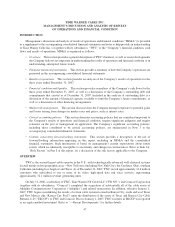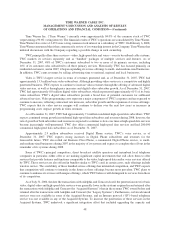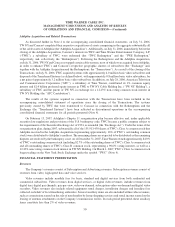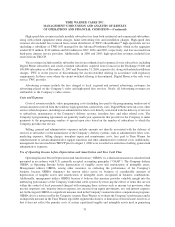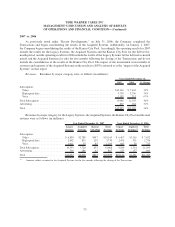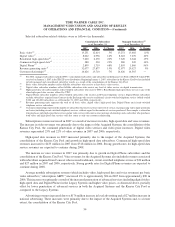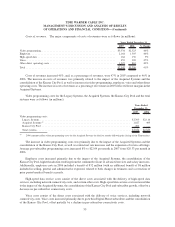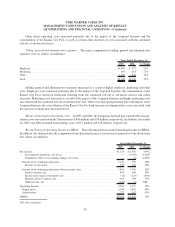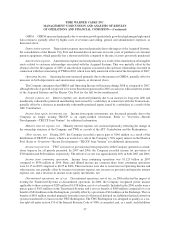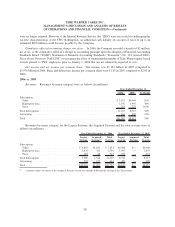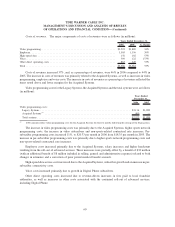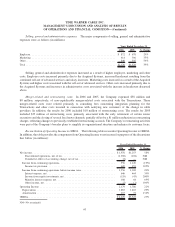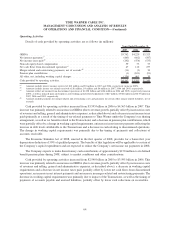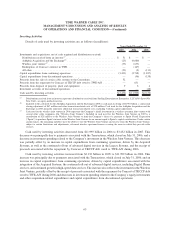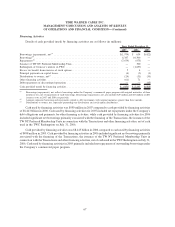Time Warner Cable 2007 Annual Report Download - page 62
Download and view the complete annual report
Please find page 62 of the 2007 Time Warner Cable annual report below. You can navigate through the pages in the report by either clicking on the pages listed below, or by using the keyword search tool below to find specific information within the annual report.OIBDA. OIBDA increased principally due to revenue growth (particularly growth in high margin high-speed
data revenues), partially offset by higher costs of revenues and selling, general and administrative expenses, as
discussed above.
Depreciation expense. Depreciation expense increased primarily due to the impact of the Acquired Systems,
the consolidation of the Kansas City Pool and demand-driven increases in recent years of purchases of customer
premise equipment, which generally has a shorter useful life compared to the mix of assets previously purchased.
Amortization expense. Amortization expense increased primarily as a result of the amortization of intangible
assets related to customer relationships associated with the Acquired Systems. This was partially offset by the
absence after the first quarter of 2007 of amortization expense associated with customer relationships recorded in
connection with the restructuring of TWE in 2003, which were fully amortized at the end of the first quarter of 2007.
Operating Income. Operating Income increased primarily due to the increase in OIBDA, partially offset by
increases in both depreciation and amortization expense, as discussed above.
The Company anticipates that OIBDA and Operating Income will increase during 2008 as compared to 2007,
although the rate of growth is expected to be lower than that experienced in 2007 as each year will include the results
of the Acquired Systems and the Kansas City Pool for the full twelve-month period.
Interest expense, net. Interest expense, net, increased primarily due to an increase in long-term debt and
mandatorily redeemable preferred membership units issued by a subsidiary in connection with the Transactions,
partially offset by a decrease in mandatorily redeemable preferred equity issued by a subsidiary as a result of the
ATC Contribution.
Income from equity investments, net. Income from equity investments, net, decreased primarily due to the
Company no longer treating TKCCP as an equity-method investment. Refer to “Overview—Recent
Developments—TKCCP Joint Venture” for additional information.
Minority interest expense, net. Minority interest expense, net, increased primarily reflecting the change in
the ownership structure of the Company and TWE as a result of the ATC Contribution and the Redemptions.
Other income, net. During 2007, the Company recorded a pretax gain of $146 million as a result of the
distribution of TKCCP’s assets, which was treated as a sale of the Company’s 50% equity interest in the Houston
Pool. Refer to “Overview—Recent Developments—TKCCP Joint Venture” for additional information.
Income tax provision. TWC’s income tax provision has been prepared as if the Company operated as a stand-
alone taxpayer for all periods presented. In 2007 and 2006, the Company recorded income tax provisions of
$740 million and $620 million, respectively. The effective tax rate was approximately 40% in both 2007 and 2006.
Income from continuing operations. Income from continuing operations was $1.123 billion in 2007
compared to $936 million in 2006. Basic and diluted income per common share from continuing operations
were $1.15 in 2007 compared to $0.95 in 2006. These increases were due to an increase in Operating Income and
other income, net, partially offset by increases in interest expense, net, income tax provision and minority interest
expense, net, and a decrease in income from equity investments, net.
Discontinued operations, net of tax. Discontinued operations, net of tax, in 2006 reflected the impact of
treating the Transferred Systems as discontinued operations. In 2006, the Company recognized pretax income
applicable to these systems of $285 million ($1.038 billion, net of a tax benefit). Included in the 2006 results were a
pretax gain of $165 million on the Transferred Systems and a net tax benefit of $800 million comprised of a tax
benefit of $814 million on the Redemptions, partially offset by a provision of $14 million on the Exchange. The tax
benefit of $814 million resulted primarily from the reversal of historical deferred tax liabilities that had existed on
systems transferred to Comcast in the TWC Redemption. The TWC Redemption was designed to qualify as a tax-
free split-off under section 355 of the Internal Revenue Code of 1986, as amended, and, as a result, such liabilities
57
TIME WARNER CABLE INC.
MANAGEMENT’S DISCUSSION AND ANALYSIS OF RESULTS
OF OPERATIONS AND FINANCIAL CONDITION—(Continued)


